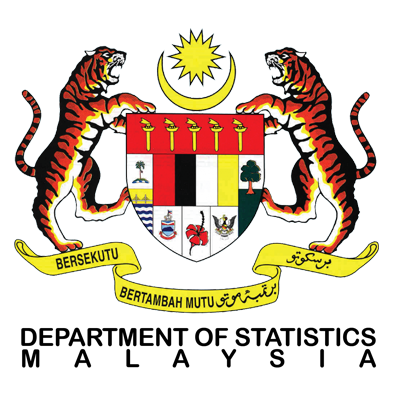Informal Sector
- Home
- Statistics
- Labour Market
- Labour Market Information
- Informal Sector
Informal Sector and Informal Employment Survey Report, 2023
Overview
INTRODUCTION
Employment in the informal sector refers to household members aged 15 to 64 years working at least one hour during the reference week as employers, employees, own-account workers and unpaid family workers. The informal sector is characterised by enterprises with fewer than ten employees and those not registered under specific forms of national legislation. This report provides statistics according to demographic and socioeconomic characteristics, namely age group, sex, strata, state, educational attainment, employment status, employment category and industry. According to the Measuring Informality Manual: A Statistical Manual on the Informal Sector and Informal Employment by the International Labour Organization (ILO), agricultural-related activities are excluded from the coverage of the Informal Sector Survey. However, since 2021, Malaysia’s Informal Sector Survey has included informal employment data for the Agriculture sector to provide a more comprehensive picture.
Meanwhile, a worker in informal employment refers to any worker who does not have access to at least one social security scheme or employment benefit. The social security schemes and employment benefits refer to: pension fund; basic health insurance; injury insurance; disability benefits; survivors’ benefits; paid annual leave; paid sick leave; paid maternity leave; and unemployment insurance. Based on the International Conference of Labour Statisticians (ICLS) guidelines, informal employment is defined as the total number of informal jobs, whether carried out in formal sector enterprises, informal sector enterprises or households.
INFORMAL EMPLOYMENT
In 2023, the total informal employment including agriculture, amounted to 3.45 million persons with a percentage contribution of 53.2 per cent (1.83 million persons) in the informal sector, followed by the formal sector at 46.1 per cent (1.59 million persons) and households with 0.7 per cent (24.2 thousand persons). Meanwhile, the number of informal employments for non-agriculture covering the formal and informal sector as well as households was 2.84 million persons. During the year, informal employment was concentrated in the formal sector (51.9%) with 1.48 million persons and followed by the informal sector (47.2%) with 1.34 million persons.
Additionally, from the distribution of informal employment by sex including agriculture, males had the highest composition with 61.0 per cent, registering 2.10 million persons and followed by females with 39.0 per cent to record 1.35 million persons in 2023. For the non-agricultural, males remained dominant with 55.7 per cent at 1.58 million persons, followed by females with 44.3 per cent to record 1.26 million persons. In the meantime, informal employment in urban areas encompassed the largest percentage of contribution at 74.9 per cent (2.58 million persons) compared to rural areas (25.1%; 0.87 million persons). Meanwhile, for the non-agriculture sector, urban areas accounted for 83.2 per cent of informal employment or equivalent to 2.37 million persons, while rural areas had 16.8 per cent or equivalent to 0.48 million persons.
EMPLOYMENT IN INFORMAL SECTOR
Employment in the informal sector for non-agriculture recorded an increase of 4.2 per cent to 1.34 million persons in 2023 compared to 2021r (-0.8%; 1.24 million persons) and 2019 (-4.8%; 1.26 million persons). On the same note, both male and female workers in the informal sector rose by 0.5 per cent to 720.4 thousand persons (2021r: 713.9 thousand persons) and 9.1 per cent to 622.1 thousand persons (2021r: 522.9 thousand persons), respectively, as compared to 2021. Conversely, males were the largest contributor to employment in the informal sector, including agriculture with 62.5 per cent or the equivalent of 1.15 million persons and females accounting for 37.5 per cent (687.3 thousand persons) in 2023.
In the meantime, most employment in the informal sector operates at home (29.1%), followed by plantation, farms, estates, sea etc. (agricultural related) with 26.8 per cent and factory/office/workshop/shop/kiosk (independent from home) with 16.5 per cent. Looking at the employment by stratum, urban areas registered an increase in employment in the informal sector, while rural areas recorded a decrease in the informal sector in 2023. Urban areas posted an increase of 5.8 per cent to 1.27 million persons (2021r: 1.13 million persons). On the other hand, employment in the informal sector in rural areas decreased by 10.0 per cent to 569.1 thousand persons (2021r: 703.0 thousand persons).
The publication of the This Informal Sector and Informal Employment Survey Report, Malaysia, 2023 can be downloaded through eStatistics portal.
Subscribe
Newsletter
Subscribe to our newsletter and stay updated
For interviews, press statement and clarification to the media, contact:
Baharudin Mohamad
Public Relation Officer
Email: baharudin[at]dosm.gov.my
Phone: 03 8090 4681
Not found what you looking for? Request data from us, through
Go to eStatistik
Email: data[at]dosm.gov.my
Phone: 03 8885 7128 (data request)










